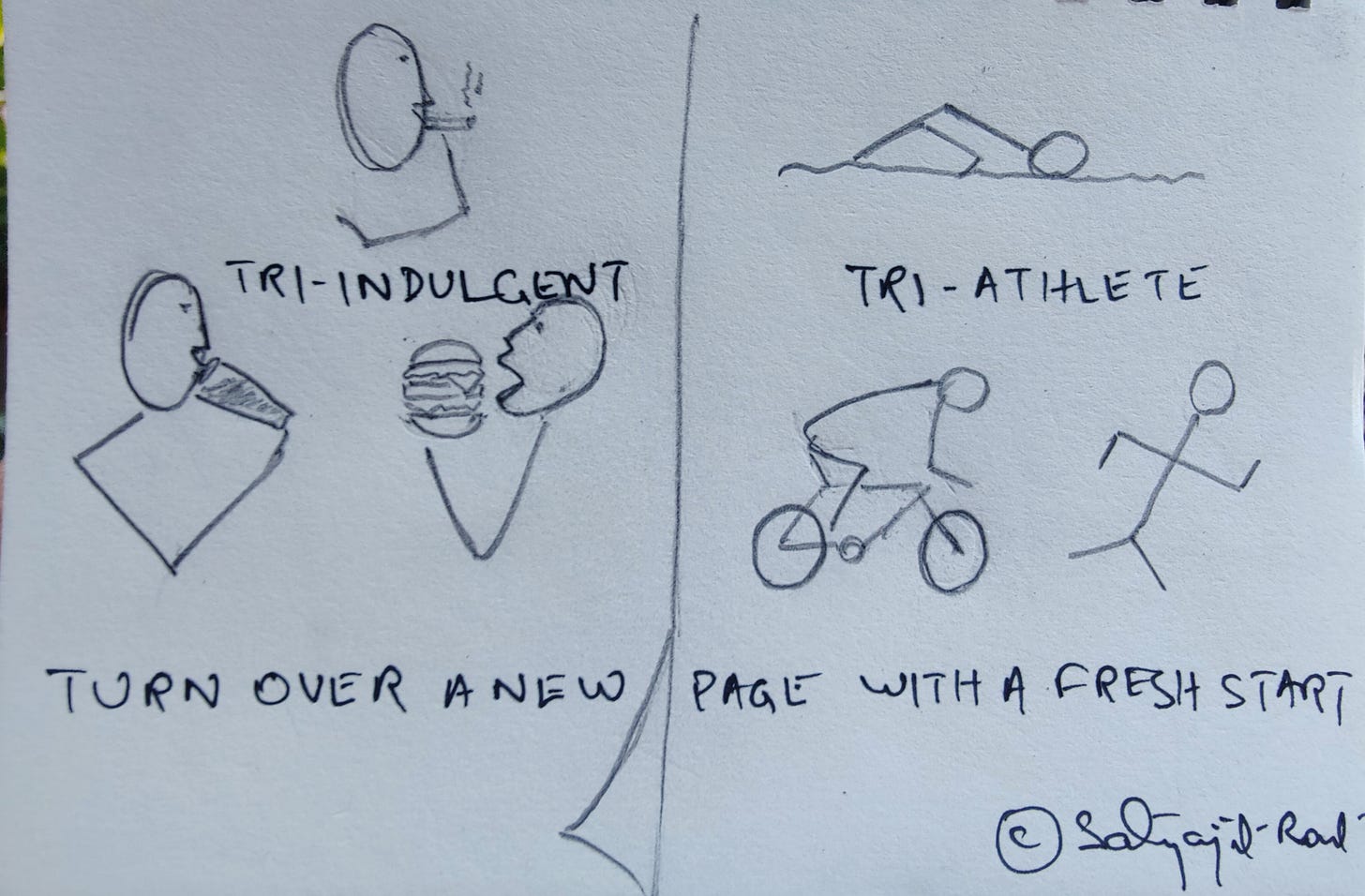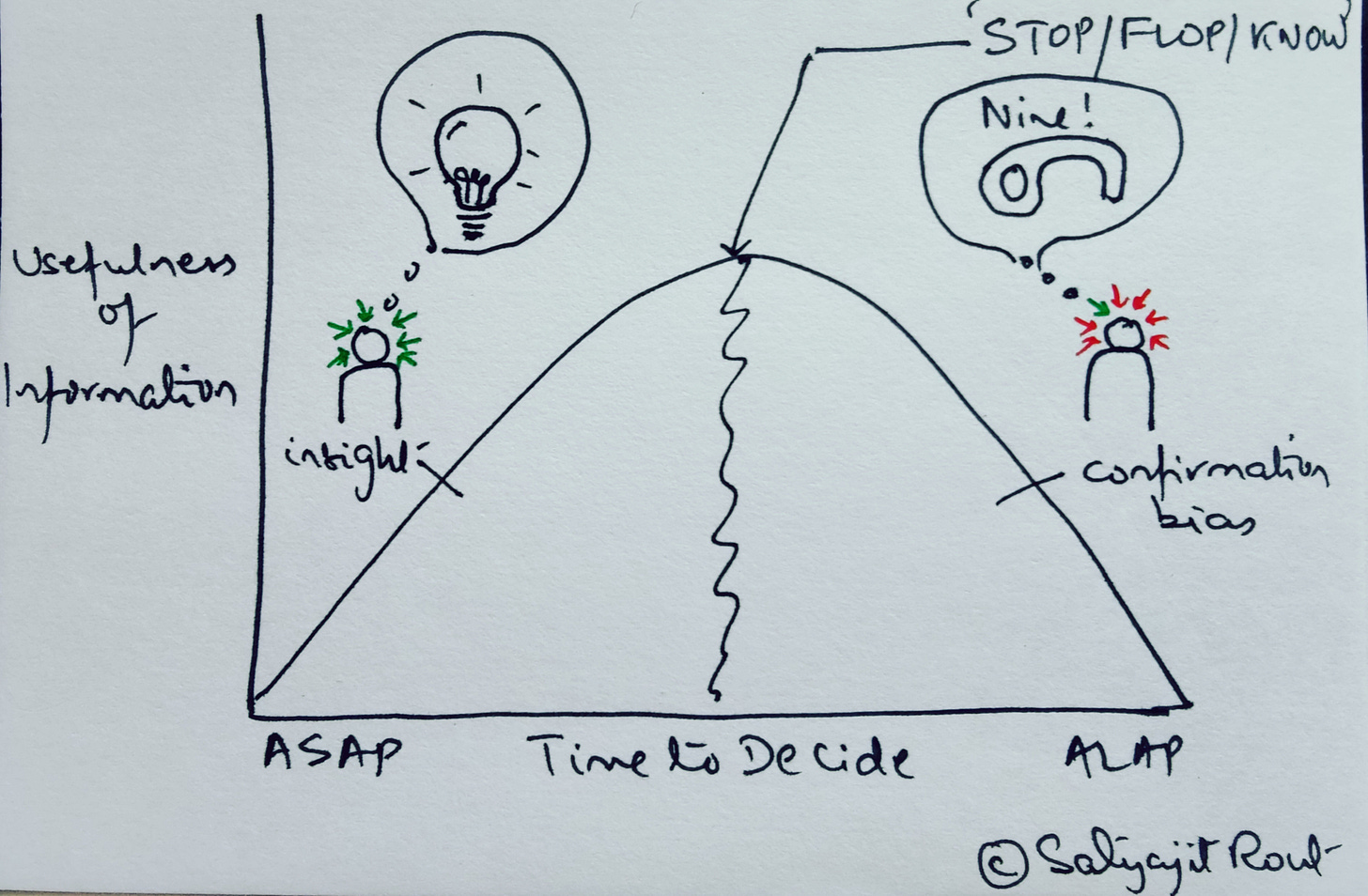The 'fresh start' effect AND when to take that big decision
Change is easier at certain times and what to look for while waiting to decide
In this issue:
The fresh start effect: Think of your life as a story. You can change the narrative if you don’t like it, but certain occasions lend themselves to new beginnings better than the rest. Here’s how you can use the fresh start effect to your benefit.
When to act and when to wait: A prioritization tool to help you identify and take smaller decisions at 10X the speed of the ones that matter most.
How to know when the moment has arrived: Timing a big decision is tricky. You could find the process agonizing and jump too early, or you could be obsessed with finding certainty and never jump. Knowing the markers in advance primes you to look out for them and be ready to jump when the moment arrives.
The ‘fresh start’ effect
We tend to repeat any routine that makes us happy. Problem is lots of things feel short-term blissful while being long-term harmful.
A new identity helps change our habits by tagging that same feel-good factor with a healthier, better routine. We still get gratified, just with different things and for longer.
Here’s the rub. Changing our self-image is a turning point in our lives. It doesn’t 𝘫𝘶𝘴𝘵 happen. We need to use certain situations, or even make them happen, to leave our past self behind and welcome our new self. Here’s how we can use 𝐭𝐡𝐞 𝐟𝐫𝐞𝐬𝐡 𝐬𝐭𝐚𝐫𝐭 𝐞𝐟𝐟𝐞𝐜𝐭 to our benefit.
Think of your life as a story. You can change the narrative if you don’t like it, but certain occasions lend themselves to new beginnings better than the rest: a new chapter, a new section, a new paragraph.
The birth of a child is a chance to reset a life, a new job to reset a career, a Monday to reset a week, a morning to reset a day. These are all occasions to start afresh, in ways big and small.
Fresh starts don’t appear only on the calendar. They could be locational (moving home), professional (switching jobs), or associated with any meaningful life event (end of a relationship). More importantly, they could be engineered–new town, new beginnings.
𝐎𝐮𝐫 𝐢𝐧𝐭𝐞𝐫𝐧𝐚𝐥 𝐬𝐨𝐟𝐭𝐰𝐚𝐫𝐞 𝐚𝐬𝐤𝐬 𝐮𝐬 𝐚𝐭 𝐭𝐡𝐞 𝐞𝐧𝐝 𝐨𝐟 𝐚 𝐬𝐭𝐚𝐠𝐞: 𝐝𝐨 𝐲𝐨𝐮 𝐰𝐚𝐧𝐭 𝐭𝐨 𝐜𝐨𝐧𝐭𝐢𝐧𝐮𝐞 𝐰𝐢𝐭𝐡 𝐭𝐡𝐞 𝐝𝐞𝐟𝐚𝐮𝐥𝐭? The question goes away if we ignore it. But if we’re willing to pause and consider, it is a chance to change the settings. We could go from a laidback student to an ambitious professional, from a carefree bachelor to a responsible spouse, from a wasteful renter to a frugal homeowner, and so on. The bigger the transition, the fresher the start.
Sometimes though things are moving just fine and a change may disrupt your flow. You have been good with your diet until the holidays show up. You’ve done your meditation practice all week but the weekend threatens to derail it. It is important to not let things slide when a good streak is broken.
So if you want to build a new habit, align your self-image with it. And time the change with a reset in your life. There are few better occasions than fresh starts to get you out of a rut. The anticipation of new things can be a motivator for positive change.
When to act and when to wait
As a leader, how do you know when to decide? Should you be quick or should you wait? Could you miss out on opportunities if you’re slow? Or will waiting out bring vital information that could decide the course for you?
Knowing when to decide can be tricky. More often, we regress to our default state. If collecting information is what lends us the semblance of a process, we do more of that. If uncertainty is what we dislike most, we tend to decide sooner than later. The first kind of behavior may lead us into 𝐚𝐧𝐚𝐥𝐲𝐬𝐢𝐬 𝐩𝐚𝐫𝐚𝐥𝐲𝐬𝐢𝐬, and the second may beget 𝐨𝐯𝐞𝐫𝐜𝐨𝐧𝐟𝐢𝐝𝐞𝐧𝐜𝐞.
𝐓𝐢𝐩 1: 𝐃𝐞𝐜𝐢𝐝𝐞 𝐚𝐬 𝐬𝐨𝐨𝐧 𝐚𝐬 𝐩𝐨𝐬𝐬𝐢𝐛𝐥𝐞 𝐨𝐫 𝐚𝐬 𝐥𝐚𝐭𝐞 𝐚𝐬 𝐩𝐨𝐬𝐬𝐢𝐛𝐥𝐞 𝐛𝐮𝐭 𝐧𝐞𝐯𝐞𝐫 𝐢𝐧 𝐛𝐞𝐭𝐰𝐞𝐞𝐧.
By now you would be familiar with the 2X2 decision matrix I’ve introduced. The point of segregating your decisions into types is to be able to quickly tell which ones matter most.
With consequential decisions, you want to avoid missing out on crucial information because there’s a steep price to pay for mistakes. Poor decisions of this type are often accompanied by a sense of ‘Oh I wish I knew this earlier’.
But it often happens that you spend too much time on inconsequential decisions, which leaves you strapped for time for the consequential ones. Imagine your inconsequential decisions as purchases under $100. Some of them have an easy refund policy. Getting these decisions wrong will not break you. You’ll have a second time.
𝐓𝐚𝐤𝐞 𝐢𝐧𝐜𝐨𝐧𝐬𝐞𝐪𝐮𝐞𝐧𝐭𝐢𝐚𝐥 𝐝𝐞𝐜𝐢𝐬𝐢𝐨𝐧𝐬 𝐚𝐭 10𝐗 𝐭𝐡𝐞 𝐬𝐩𝐞𝐞𝐝 𝐨𝐟 𝐜𝐨𝐧𝐬𝐞𝐪𝐮𝐞𝐧𝐭𝐢𝐚𝐥 𝐝𝐞𝐜𝐢𝐬𝐢𝐨𝐧𝐬.
If you’re the leader of a team, slowing down on everyday decisions may be deflating for your team. The payoff is meager. Delegate all inconsequential decisions to those in the team for whom they matter the most.
𝐓𝐢𝐩 2: 𝐂𝐚𝐫𝐯𝐞 𝐨𝐮𝐭 𝐭𝐢𝐦𝐞 𝐟𝐨𝐫 𝐜𝐨𝐧𝐬𝐞𝐪𝐮𝐞𝐧𝐭𝐢𝐚𝐥 𝐝𝐞𝐜𝐢𝐬𝐢𝐨𝐧𝐬 𝐛𝐲 𝐦𝐚𝐤𝐢𝐧𝐠 𝐚𝐥𝐥 𝐢𝐧𝐜𝐨𝐧𝐬𝐞𝐪𝐮𝐞𝐧𝐭𝐢𝐚𝐥 𝐝𝐞𝐜𝐢𝐬𝐢𝐨𝐧𝐬 𝐪𝐮𝐢𝐜𝐤𝐥𝐲, 𝐢𝐧𝐬𝐭𝐚𝐧𝐭𝐥𝐲.
I must say here that the definition of consequence or reversibility may not be uniform. With scale, things tend to become unwieldy.
For startups most decisions are quickly reversible with a low cost. Think digital ads: high volume, high turnover, continuous refinement. Larger organizations are not quite as nimble. Just like outdoor ads: fewer, bigger, slower.
But the best organizations evolve with scale. They find entrepreneurs within teams, they run multiple decision-making processes in parallel to optimize for time. Think outdoor ads that combine digital and analog.
If you find yourself wondering why you have so little time for important decisions, think of how you are allocating your attention.
What to look for while waiting to decide
By now you would know that the 2X2 decision matrix is really a prioritization tool. Its point is to help you strip down what’s on your mind to the most essential.
Imagine you do that. You make the smaller decisions as soon as possible and are willing to wait until as late as possible for the consequential-irreversible decision. You may be wondering: How do I now know when it’s time to act on the information I have and not wait any more? How can I avoid being too late?
I’ve learned a simple shortcut from Farnam Street that helps me time a big decision. It’s called STOP, FLOP, or KNOW.
It’s time to decide:
When you STOP gathering useful information
When you First Lose an OPportunity
When you have gathered a piece of evidence that you just KNOW makes the choice clear
STOP
If you’ve held onto a job or a relationship for too long, you would know that there’s a point beyond which new information yields diminishing returns.
Research shows that beyond a point you tend to cherry-pick information that supports what you want to happen (confirmation bias). You feel twice as confident but are not any more accurate with the additional information. That’s risky if you think of your big decision as a consequential-irreversible bet.
FLOP
You wait on a big decision because competing options could be equally compelling and you want to look for evidence that sets them apart. But when you lose an opportunity while holding out, consider that you have activated the tripwire for action. Waiting further is counterproductive. You are losing birds in the bush and you’ve nothing in hand.
KNOW
Sometimes a critical piece of information that you’ve gathered confirms your decision. It is the clincher. It leads to an ‘Aha’ moment. It clarifies all doubts.
While waiting to make an irreversible-consequential decision, you’re trying to reduce uncertainty. You could find that process agonizing and jump too early, or you could be obsessed with finding certainty and never jump. Knowing the markers in advance primes you to look out for them and be ready to jump when the moment arrives. This is a welcome relief from the endless back-and-forth that you may be forced into without these markers.
That’s it for this week. Thanks for reading!
Next week, we’ll continue our exploration into decision-making and habit-building with:
How to hack the habit-building loop
How to keep options open while waiting to make a big decision
How to avoid problems so that you don’t have to solve them
Every week I stitch together durable insights into thinking better. If something in this piece resonated with you, do hit subscribe and give me a lift 🚀




